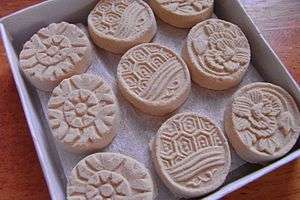Higashi (food)
Higashi (Japanese: 干菓子 or 乾菓子, dry confectionery), is a type of wagashi, which is dry and contains very little moisture, and thus keeps relatively longer than other kinds of wagashi.
 | |
| Type | Wagashi |
|---|---|
| Place of origin | Japan |
| Main ingredients | Usually rice flour |
| Variations | Goshikiitō (bainiku, hakka, nikkei, shōga, yuzu), hakusansekkei, hanakazura, mugirakushizuka, nininsuzuka, rakugan, Shigure no Matsu, suiko |
Overview
The concept of higashi is comparable to the antonym of namagashi, and the definition can include rakugan, konpeitō, senbei, arare, and so on (though usually senbei and similar snack foods are not sweet and thus the word kashi/wagashi is not so fitting).
A narrower definition of higashi may confine the recipe to one or more kinds of sugar, with a particular sort of flour, and some other additives, while there are some made solely of sugars.
The flour used in higashi is usually made of rice, which has many different varieties of its own. Flours made of other ingredients, like azuki, soybean or green pea and starches are often used too.
Those made with wasanbon, Japanese premium fine-grained sugar made by traditional methods, are commonly regarded as the finest ones. The most common and well-known higashi is rakugan, but the definition of the word is somewhat vague and sometimes not suitable for a certain type of wagashi, so the word higashi would be better in some cases.
Higashi are often served at Japanese tea ceremonies.
List of Higashi
- Goshikiitō (五色糖) – Five flavors, Bainiku (pickled ume), Hakka (Japanese mint), Nikkei (cinnamon), Shōga (ginger), and Yuzu (citron) each with distinct shapes.
- Hakusansekkei (白山雪渓)
- Hanakazura (花かずら)
- Mugirakushizuka (麦らく静)
- Nininsuzuka (二人静)
- Rakugan (落雁)
- Shigure no Matsu (時雨の松)
- Suiko (推古) – Aka (pinkish red) and Shiro (white) are available.